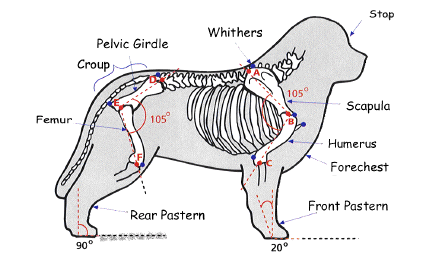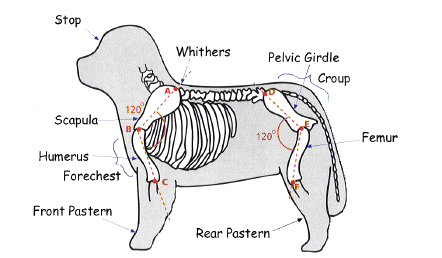The Newfoundland Club
Established the world's first Newfoundland Breed Standard
Breed Standard
(Last updated 01 July 2024)A breed standard is the guideline which describes the ideal characteristics, temperament and appearance including the correct colour of a breed and ensures that the breed is fit for function. Absolute soundness is essential. Breeders and judges should at all times be careful to avoid obvious conditions or exaggerations which would be detrimental in any way to the health, welfare or soundness of this breed.
From time to time certain conditions or exaggerations may be considered to have the potential to affect dogs in some breeds adversely, and judges and breeders are requested to refer to the Breed Watch information related to this breed for details of any such current issues. If a feature or quality is desirable it should only be present in the right measure. However if a dog possesses a feature, characteristic or colour described as highly undesirable, it must not be rewarded in the show ring.
-
General appearanceWell balanced, compact, impresses with strength, great activity and effortless power. Large, double coated, deep bodied, muscular and strong with substantial bone throughout, but not giving heavy inactive appearance. Noble, majestic and powerful.
-
CharacteristicsA multipurpose dog, at home on land and in water, the Newfoundland is capable of draught work and shows natural lifesaving abilities. He has evolved to withstand the rigours of extreme climate and the sea's adversity. Devoted companion.
-
TemperamentExceptionally gentle, docile nature.
-
Head and skullHead broad and relatively large, slightly arched crown, occipital bone well developed. No decided stop. Muzzle broad throughout its length and rather square, clean cut, covered with short fine hair. Depth and length of muzzle approximately equal. Length from tip of nose to the stop slightly less than from stop to occiput. Forehead, muzzle and face free of wrinkle. Nostrils large, open, well-pigmented. Nose: Black in black, and in white and black dogs; brown in brown dogs.
-
EyesRelatively small, almond shaped, not showing haw, set rather wide apart. Eyelids must fit closely, free from obvious eye problems. Colour: dark brown in black, or in white and black dogs, lighter shades of brown which complement the coat colour permitted in brown dogs. Any other eye colour is undesirable.
-
EarsTriangular, relatively small, with rounded tips, covered with short hair. Set level with, or slightly above the brow, lying close to head.
-
MouthSoft and well covered by tight lips. Loose lips and heavy jowls undesirable. Scissor bite is preferred i.e. upper teeth overlapping lower teeth and set square to the jaws, but pincer bite tolerated.
-
NeckStrong, muscular, well set on to shoulders, long enough to permit dignified head carriage. No excessive dewlap.
-
ForequartersShoulders muscular and well laid back. Elbows directly below the highest point of withers, fitting close to sides. Forelegs well muscled, substantially boned, perfectly straight and parallel. Distance from elbow to ground about half height at withers. Pasterns are strong and slightly sloping.
-
BodyLength of body from point of shoulders to point of buttock is greater than height at withers. Body is compact. Topline level and firm. Back broad, strong and muscular. Loin well muscled. Croup broad and slightly sloping. Chest deep, fairly broad with brisket reaching at least to elbows. Ribs well sprung. Flank deep. Underline almost level and never tucked up. In bitches, body may be slightly longer.
-
HindquartersPowerful, muscular, substantially boned. Upper thighs wide and muscular. Stifle well bent, but not giving a crouching appearance. Lower thighs strong and fairly long. Hocks well let down and well apart, parallel to each other; they turn neither in nor out. Viewed from rear, legs straight and parallel. Cow hocks highly undesirable.
-
FeetLarge, well rounded, tight and cat like. Webbing of toes is present. Splayed or turned out feet highly undesirable.
-
TailTail set in line of croup. Strong and broad at base, reaching to or slightly below hock. Fair thickness, well covered by hair. When standing the tail hangs downwards with slight curve at end; when moving carried slightly up, and when excited straight out with only a slight curve at end. Tails with a kink or curled over the back highly undesirable.
-
Gait/MovementFree with characteristic slight roll of skin. Good reach and strong drive, giving impression of effortless power while retaining level top line. When in motion slight toeing in at front is acceptable.
-
CoatDouble, flat and dense. Outer coat of coarse texture and oily nature, water resistant. Slight wave permissible. Undercoat soft and dense. When brushed the wrong way coat falls back into place naturally. Feathering present on all legs.
-
Colour
Only permitted colours are:
Black: dull jet black may be tinged with bronze. White markings acceptable on chest, toes and tip of tail.
Brown: Chocolate or bronze. White markings acceptable on chest, toes and tip of tail.
Landseer (white and black): predominantly white with black markings. Head with or without white blaze.
Black saddle, black rump extending to tail. Coat white with minimal ticking. Markings should be considered only when judging dogs of otherwise comparable quality and never at expense of type, structure and soundness. -
Size
While size and weight are important it is essential that balance, symmetry, and substance is maintained.Average height at shoulder Average weight Dogs: 28 ins (71 cms) 141-152 lbs (64-69 kgs) Bitches: 26 ins (66 cms) 110-120 lbs (50-54.5 kgs) -
FaultsAny departure from the foregoing points should be considered a fault and the seriousness with which the fault should be regarded should be in exact proportion to its degree and its effect upon the health and welfare of the dog and on the dog’s ability to perform its traditional work.
-
NoteMale animals should have two apparently normal testicles fully descended into the scrotum.
The Breed Standard is reproduced on this page courtesy of the Royal Kennel Club. View on the Royal Kennel Club web site
Construction
These diagrams do not form part of the Breed Standard. They are intended to give some information regarding nomenclature and skeletal arrangement, particularly in regard to angulation.

Good Construction
